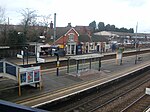Ampthill
All pages needing cleanupAmpthillCentral Bedfordshire DistrictCivil parishes in BedfordshireMarket towns in Bedfordshire ... and 3 more
OpenDomesdayTowns in BedfordshireUse British English from December 2013

Ampthill () is a town and civil parish in Bedfordshire, England, between Bedford and Luton, with a population estimate of 8,100 (Mid year estimate 2017 from the ONS). It is administered by Ampthill Town Council. The ward of Ampthill which also includes Maulden and Clophill has an estimated population of 13,280 and is administered by Central Bedfordshire Council.
Excerpt from the Wikipedia article Ampthill (License: CC BY-SA 3.0, Authors, Images).Ampthill
Queens Road,
Geographical coordinates (GPS) Address Nearby Places Show on map
Geographical coordinates (GPS)
| Latitude | Longitude |
|---|---|
| N 52.0263 ° | E -0.4906 ° |
Address
Queens Road
MK45 2TD
England, United Kingdom
Open on Google Maps






